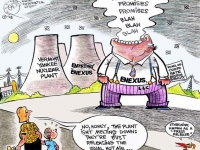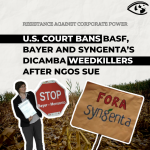Ducking Responsibility: Entergy Spins Its Nukes

When Vermont regulators approved the sale of Yankee Nuclear, the state's only nuclear power plant, to Entergy in 2001, many heralded it as a move that would promote cheap, safe power. Vermont Yankee would be run by one of the nation's largest nuclear operators - a Fortune 500 company to boot - rather than a group of in-state utilities.
But rather than getting top-notch industry expertise and management, Vermonters saw a spate of mishaps at the plant. Just last year a spent fuel rod went missing and there was the spectacular collapse of cooling tower sections. The bad news led Republican Governor Jim Douglas to say that it seems as if "Homer Simpson is running the place."
Now, seven years after buying the plant, Entergy is using a complex restructuring scheme to back away from its ownership of Vermont Yankee and the rest of its northeast fleet of nuclear reactors.
This move is mirrored throughout the nuclear industry as older plants reach the end of their productive lives and must be decommissioned at enormous cost to owners, taxpayers or both. At the same time, many utilities are trying to cash in on the image that nuclear power is part of the climate change solution and reap record profits as a spike in natural gas and oil costs boosts power prices.
One way the nuclear industry is dealing with the changing energy climate is though shell games: They are restructuring and setting up complex holding companies that push profits to shareholders, while reneging on side agreements that made license extensions, power up-rates or ownership changes palatable to state and local regulators.
Entergy is spinning off all its plants into a separate limited liability company, Enexus, absolving itself of any responsibility to the nuclear reactor fleet it now owns, or to the states in which they are located. The deal would add $4 billion to Entergy's bottom line, but would leave the newly created LLC saddled from the start with $4 billion in debt.
Entergy owns and operates 11 power plants with approximately 30,000 megawatts of electric generating capacity, and it is the second-largest nuclear generating corporation in the United States, after Exelon. Entergy has annual revenues of more than $11 billion and employs roughly 14,300 people in more than a dozen states.
Seeking Approval
The Nuclear Regulatory Commission (NRC) and the Federal Energy Regulatory Commission (FERC) have approved the Vermont restructuring, but Entergy still needs the OK from the Internal Revenue Service, the Securities Exchange Commission, and regulators in Vermont and New York. It hopes to complete the restructuring by year's end.
`
"We're pleased with the staff's decision of the transfer of the licenses and are looking forward to the completion of the spinoff process," said Entergy spokesperson Michael Burns. "We strongly believe it will provide benefits to all of the plant's stakeholders and communities."
In Vermont, some of those stakeholders are less than pleased with hosting an aging nuclear power plant with a shaky safety record. When Vermont Yankee was built in 1972, its life expectancy was 40 years. With 2012 looming, it is seeking an extension to operate an additional 20 years. In 2006, despite protests, it was granted permission to produce 20 percent more power than it was originally designed to generate. That output boost means it sucks in more water from, and pumps hotter water out into, the nearby Connecticut River. Some critics have pointed out that the original plant was not designed to run so hard for so long, and, indeed, a recent study fulfilled predictions that radiation emissions would increase along with power.
Enexus: Below the Grade The Vermont Public Service Board recently held hearings at which Entergy sought approval to spin off Vermont Yankee to Enexus. Enexus which needs to borrow $4.5 billion, "is rated as 'speculative,' or below investment grade," Vermont Public Radio reported. Lower ratings reflect doubt about a company's ability to repay debts. The board's Public Advocate Sarah Hofmann questioned Entergy's financial expert, Susan Abbott, about whether Enexus was credit worthy: Hofmann: "Would you agree with me that Enexus is not as financially sound as Entergy is today?" Abbott: "That's a very difficult question to answer yes or no." Hofmann: "Well, let me try to break it down for you. Is Enexus going to be rated investment grade?" Abbott: "Ah. Probably not." |
Decommissioning, when it inevitably comes, is expected to cost at least $800 million. The clean-up fund currently has only $400 million, which is supposed to cover not only mothballing and purging the plant, but returning the site to be in keeping with the nearby cow pastures, farm crops, elementary school and white clapboard houses.
Residents and lawmakers opposed to the restructuring, and to Yankee's license extension, have so far failed to coalesce their forces. The woefully underfunded activists of the New England Coalition and Citizens Awareness Network have been the underdogs in this fight - often taking on well-heeled lawyers from both the NRC and Entergy in one hearing.
That may change. A statewide tour last year aimed to educate Vermonters about the ongoing problems that a nuclear power plant poses to residents. It highlighted radiation emissions and the impact a major accident could have on the state's agriculture and health.
And, the string of mishaps at the plant may have done more to shake the confidence of northern residents and policymakers than could any well-reasoned argument in the arcane hearing rooms of the NRC.
The Spin
According to Entergy, the spin-off corporation Enexus will own six wholesale reactors that had been part of Entergy's 11-reactor fleet, including two at the Indian Point Energy Center in Buchanan, New York; and one each at Vermont Yankee in Vernon, Vermont; Pilgrim Station in Plymouth, Massachusetts; the James A. FitzPatrick plant near Oswego, New York; and the Palisades plant in Covert, Michigan.
Headquartered in Jackson, Mississippi, Enexus Energy Corporation says it will be "the nation's first stand-alone, publicly traded nuclear-energy generating and marketing company" and will "own approximately 5,000 megawatts of nuclear power generation."
But to further complicate matters, if and when the deal is finally approved neither of the parent companies (Entergy and Enexus) will hold Vermont Yankee's operating license. Rather a separate spinoff company, EquaGen, a joint venture of the parent companies, will act as the holding company that owns the six Northeast reactors.
Confused? So are activists and regulators looking to ensure that when the plant needs decommissioning or if it has a serious accident, there will be a clear line of responsibility and sufficient financial resources to deal with the problems. In short, they want Entergy to be the company providing the financial backstop.
"This restructuring is absolutely bad for Vermont, and Vermont taxpayers are going to get screwed," warns Bob Stannard, a lobbyist hired by anti-nuclear groups to make their case to lawmakers.
If the tangled chain of responsibility is not reassuring, the name is supposed to be. Entergy officials say the brand Enexus was chosen to "capture the appeal of reliable nuclear power, which is virtually emissions-free and supports U.S. energy independence, while preparing for future energy demands." The name is a hybrid between "energy" and "nexus" and "describes nuclear power's role in the nexus between the world's growing energy demand and the United States' need for clean, environmentally friendly power."
Certainly, the company was looking for something better than SpinCo or NewCo - both monikers Entergy used before settling on Enexus and the tag line: "Today's energy - tomorrow's solution."
Resistance from Below
The reorganization may be a solution for Entergy, but state regulators in Vermont and New York are not meeting the convoluted arrangement with open arms.
Regulators in these two states believe the spinoff has more to do with Entergy finding a way to wriggle out from under financial agreements totaling in the hundreds of millions of dollars, and potentially saddling taxpayers with hundreds of millions in cleanup and closure costs once the nuclear reactors are shut down.
The Vermont Department of Public Service (DPS), which represents ratepayers before state regulators, opposes the reorganization.
"The department cannot support the Enexus corporate structure as proposed. Enexus as proposed would have far too much debt, as well as limited resources to meet any capital expenses that may be required for continued operation," said Stephen Wark, a DPS spokesperson.
In late July, three days of technical hearings were held before the quasi-judicial Public Service Board. Consultants hired to review Entergy's reorganization testified that there would not be enough money in the decommissioning fund to dismantle the plant if the reactor is shut down in 2012, when Yankee's current operating license expires. While the NRC has OK'd a 20-year extension, it must also be approved by both the Public Service Board and the Democratic Party-controlled state legislature.
The DPS has other concerns, including the fact that Enexus, in its restructuring documents, failed to identify or reference an "Employee Concerns Program" as required by the federal whistleblower law.
Holding the Bag
Like death and taxes, the decommissioning of nuclear power plants is inevitable. Today's price for safely dismantling the radioactive components, transporting them to nuclear waste dumps, and storing material on site is estimated at roughly $600-$750 million per reactor.
By 2032 those costs could rise precipitously. And since the federal government has failed to find a single repository for such waste, there still may be no place to send the radioactive material. That means that after the corporations have shut down geriatric plants, states will have to find a way to store high-level nuclear waste at or near reactor sites.
Anticipating that inevitable day, and spurred by Entergy's reorganization, Vermont lawmakers passed a bill this spring that, as a condition for restructuring approval, requires the Louisiana-based company to pony up $400 million and place it in the decommissioning fund for Vermont Yankee.
Legislators were worried that since Entergy was walking away from the plant as an owner, taxpayers would be on the hook for decommissioning costs.
In May, Entergy's top Vermont lobbyist, Brian Cosgrove, argued against the bill, telling listeners on a popular local morning talk show that the $400 million liability would affect the company's credit rating, and be a drag on the bottom line.
But according to Standard & Poor's, a Wall Street ratings agency, the proposed additional $400 million for the decommissioning fund will not affect Entergy's bond rating.
And it sure doesn't look like the payment would kill profits. Entergy reported first-quarter earnings of more than $308 million, a 45 percent jump from a year earlier. It announced earnings of more than $289 million for the second quarter of the year, up $22 million from a year earlier.
Despite Entergy's strong financial position, Republican Governor Jim Douglas opposed the legislature's move, claiming the extra money Entergy was being forced to pay would eventually come out of ratepayers' pockets in higher power rates as the costs were passed along to utilities. Lawmakers defied the governor and passed a bill calling on Entergy to keep its word and put its money where its mouth was. Douglas then promptly vetoed the legislation.
Stannard call the NRC an industry "lapdog," for going along with the restructuring plans and financial shenanigans. "All this clearly indicates to policymakers in Vermont that we should have no faith in the NRC to protect our interests; we have to rely on ourselves to protect our interests," said the anti-nuke lobbyist. "The NRC has been lockstep with Entergy in general, and with this plant in particular from the get-go. Entergy is a big company accustomed with getting its way, and it is having a meltdown over the fact that the little state of Vermont has purview over this restructuring, or a license extension."
In short, Stannard believes Vermont officials should more strongly oppose the deal and not rely on either the NRC or on officials in neighboring states.
New York Powers Up
One of those neighboring states is also concerned about Entergy's plans. New York Attorney General Andrew Cuomo told the New York Times: "Entergy's plan is ill-conceived on a number of levels. It could ultimately cost taxpayers hundreds of millions of dollars, does nothing to guarantee adequate decontamination of the site, and does not anticipate a future New York without Indian Point."
The transfer of Entergy to Enexus could cost New York residents money because Entergy agreed to a special revenue-sharing arrangement with the New York Power Authority (NYPA). Under the agreement, in the next six years Entergy is to provide $432 million to NYPA. In turn, the authority provides low-cost electricity to businesses and municipalities. It also oversees energy efficiency and energy retrofitting programs.
Westchester County Executive Andrew Spano, where the Indian Point nuclear reactor is located, also opposes the deal. He says the complex spinoff arrangement makes it difficult to determine who will be ultimately responsible if something goes wrong. Indian Point is located less than 25 miles from mid-town Manhattan.
Entergy officials, in letters and court filings, have rejected the state's arguments and said it was "in full compliance with all terms and conditions" of the agreement. It plans to spin off Enexus to its own shareholders, who could then sell or hold the new shares.
Christine Pritchard, a spokesperson for the Power Authority, said it would fight Entergy in court if necessary.
"If the spinoff of Entergy's nuclear plants is approved and, based upon the structure of the spinoff, Entergy then tries to evade its obligations under the value sharing agreements, NYPA intends fully to protect its rights and challenge that unwarranted conduct in a court of law," she said.
Same Old Shell Game
Setting up shell companies and limited-liability corporations to shield the parent company is nothing new in the nuclear power industry. A 2002 report into this growing practice raised concern about the eventual impact the trend would have on the marketplace, and potentially on the public purse.
Just take a look at the recent implosions related to the subprime industry, and Enron and WorldCom before it. That's the same kind of financial hocus pocus going on in the energy industry.
"With years of reckless undermining of economic and financial regulation now exposed in a series of catastrophic financial collapses, investigators turning over rocks keep finding the same agents of decay: demands for short term "performance" in the private sector compounded by regulatory cutbacks, underqualified commission appointments, Congressional hearings harassing public protection initiatives, pressure to deregulate more and faster - a ruinous mixture of money, pressure, overconfidence, complexity and ideology," wrote former NRC Commissioner Peter Bradford in his introduction to the 2002 report by Synapse Energy Economics. The report was prepared for the STAR Foundation and Riverkeeper.
Bradford, who served under President Jimmy Carter, also argued that federal energy regulators weren't schooled in the ability to analyze these new, complex financial arrangements.
"During all those years, health and safety regulation got the same debilitating treatment from Congress and the presidency as its financial counterparts. How long before those chickens come home to roost, and where will the roosting be?" he pondered.
No major accidents have occurred at Entergy plants, but the company's current efforts mark a heightened level of corporate restructuring that will insulate it if any do.
"Entergy Corporation was a pioneer in establishing separate corporate entities to own and operate nuclear power plants," the report claimed, citing a seven-year history of setting up shell companies.
At the time, Entergy owned its reactors through a variety of wholly-owned retail public utility companies, and wholly-owned subsidiaries. In some cases, separate subsidiaries were set up around single reactors, with each subsidiary owning a portion of each other's reactor. Most of these subsidiaries were under the umbrella of Entergy Nuclear Holding Company.
Their reasoning was simple: "The use of holding companies below Entergy Nuclear Holding Company allows Entergy to segregate various types of financing, investment, and business activities, and by doing so, enables Entergy to better manage and control risks associated with these activities," the report stated.
In other words, shareholders get the benefits with none of the risk. The federal government has backed this equation by ensuring that nuclear power plant owners are shielded, to some extent, from having to clean up accidents.
After the 1979 accident at Three Mile Island, the federal nuclear self-insurance requirement - the Price-Anderson Act - was increased from $560 million to the current $9.3 billion. In addition, each plant was required to set up a dedicated decommissioning trust fund to assure that funds would be available to clean up a closed plant.
But the Star Foundation-Riverkeeper report finds that "with the passage of two more decades, renewed complacency has eroded these safeguards."
"The consolidation of nuclear ownership now risks the shifting of accident and decommissioning costs from the plant owners to the general public because the relatively secure financial backing of substantial utility companies has in many cases been replaced by a limited liability subsidiary whose only asset is an individual nuclear power plant," the report found.
The report also warned against the growing consolidation in the market occurring while companies were creating more complex ownership structures.
"The limited liability structures being utilized are effective mechanisms for transferring profits to the parent/owner while avoiding tax payments. They also provide a financial shield for the parent/owner if an accident, equipment failure, safety upgrade, or unusual maintenance need at one particular plant creates a large, unanticipated cost. The parent/owner can walk away, by declaring bankruptcy for that separate entity, without jeopardizing its other nuclear and non-nuclear investments," the report concluded.
No Nukes of the North
In Vermont, activists opposed to the ongoing operation of Vermont Yankee and to the clever shielding of its corporate owners from the risks of running a nuclear power plant (and pushing that risk back on the communities) have no intention of letting Entergy simply change the rules mid-game.
Opponents hope to rekindle some of the spirit of the 1980s when a statewide coalition formed and backed numerous resolutions at annual town meetings calling for a nuclear weapons freeze.
The Citizens Awareness Network and several peace and justice groups will stage a statewide tour in early August to try to generate support for closing down Vermont Yankee in 2012. The march and tour begins in Bennington and ends up in Burlington on Hiroshima-Nagasaki day after a stop in the state's capital of Montpelier.
And, Montpelier will be the stage in 2008 as Vermonters take up the thorny issue of extending Vermont Yankee's license another 20 years, ending with a potential vote in the Legislature.
- 182 Health
- 183 Environment
- 190 Natural Resources
- 208 Regulation



